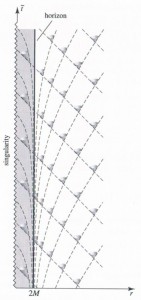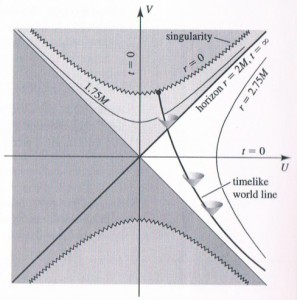Physicist: Before answering your question, I’ll waste your time with two quick asides.
First: The place where the “ripping” might occur would be at the singularity. “Singularity” is actually a very general term that roughly means “something goes to infinity in finite time or distance”. Singularities are surprisingly common in nature and math. For example, if you look at the flow of water around a drain, you’ll find that the math predicts that the water will spin faster the closer to the center it is. In fact, the water should spin infinitely fast exactly at the center. However, if you actually try this experiment you’ll find that there is no water at the exact center. Either you’ll have a whirlpool (so there’s air at the center), or the water will flash into steam (from a drop in pressure). The universe truly is a slippery eel. Every time the math predicts a singularity, the universe finds someway to cheat and get around it. The math of General Relativity predicts that the stretching of space will be infinite at the center of a black hole. But my inner cynic says that the universe probably does something duplicitous and clever, and we need to do an experiment to figure out what that is. Sadly, we’ll never do that experiment (can’t get out of a black hole), so the inside of black holes will be ready fodder for sci-fi authors for a long time yet.
Second: The source of the idea that black holes might go somewhere is what might be called “mathematically based paranoia”. Often in physics simple experiments will lead to simple math, that in turn makes very bizarre predictions. Relativistic time dilation, quantum tunneling, and anti-particles are all examples of this. Anti-particles were literally discovered because of a simple term, that had both a positive and negative solution. Experiences like these make physicists very careful about throwing out solutions to equations, just because they’re “unreasonable”. In the case of black holes the equations are the “Kruskal-Szekeres coordinates“, which are used to make the behavior of light and matter in, and around, black holes more intuitive.

Radial Direction vs. Time near a blackhole
The dotted lines are sample light paths going inward and outward. All matter must travel between these lines (matter can’t travel faster than light). Notice that the lines are really messed up near the event horizon.
-

U vs. V (the Kruskal-Szekeres coordinates)
In these coordinates the graph is cleaned up. Time points roughly “up” on this graph, light always travels the same way, and the lightcones are thus “unbent”. Everything outside of the blackhole is now in the rightmost triangle. But the space in the leftmost triangle seems to work the same as the space on the right. Could it exist? Physicists wouldn’t want to rule it out immediately. Since light travels at 45º on this graph, you would have to travel faster than light to find out for sure however. So this is where the idea that blackholes could lead to “somewhere else” comes from.
Finally, to actually answer the original question:
Maybe? It may happen that as matter gathers in one place the space around it “pinches off”. To the outside this would look like the formation of a blackhole. You can picture this like water drops forming, and then falling off of the bottom of a flat surface. Time in the new universe would be independent of time in our universe. Not just “flowing at different rates”, but completely apart. There would be no way to talk about “what’s happening right now in the other universe”.

Could our universe be a pinched off blackhole? Sure? There’s no good reason (that I’m aware of) to doubt conservation of matter and energy, so it would have had to be a really (really) big one.
It’s worth mentioning that whether or not blackholes go anywhere is fundamentally unimportant, since: 1) You can’t actually pass the event horizon (time from an outside perspective slows to zero on approach). 2) On approach you’ll be torn down to your atoms by the tidal forces. 3) You’d never get back out to tell the tale.
Both of the above graphs were happily stolen from “Gravity”, by James Hartle.
The water drop photo is from “Drop Shots!, Reflections on the Waterdrop“.







Pingback: Q: Can one truly create something from nothing? If matter formed from energy (as in the Big Bang expansion), where did the energy come from? « Ask a Mathematician / Ask a Physicist